The Koidanov Hasidic Dynasty
by Jeff Ferber
"It's a warm day with rays of sunlight permeating the air and penetrating the kloiz's windows. On its rooftop the Koidanov Hasidim dance in a giddy stupor induced by the joyous overindulgence that is tolerated — even encouraged — on
Simhat Torah. One by one the little shuls emptied onto the Shulhoif, except for the Koidanov Shtibl. "Bim-bam, bim-bam!" resounds from within. The Koidanov Hasidim put no stock in a hazzan and m'shor'rim; they're singing and dancing unaccompanied — with great fervor. In fact, the impression given is that this shtibl is about to uproot itself from the mostly mitnagdic Shulhoif and rise up to heaven in a whirlwind of wildly flying beards, flapping kapotes and fanning gartels"
–the writer Chaim Grade describing a chance encounter with the Koidanov Hasidim in Vilna between the 1st and 2nd world wars1
The Koidanov Hasidim are known for their soulful and often animated approach to prayer and observance. The Koidanov Hasidic dynasty, like all Hasidic dynasties, traces its roots back to Yisroel ben Eliezer, the Baal Shem Tov (1698-1760). The Besht was born in the town of Okop in the Podolia area of the Western Ukraine. He established himself in the town of Medzeboz, where he attracted many disciples, including his eventual successor, Rabbi Dov Ber, the Maggid of Mezeritch (1700-1772). R. Dov Ber established his base in the area of Volynia, where he focused his attention on raising a close circle of disciples to spread the movement.2
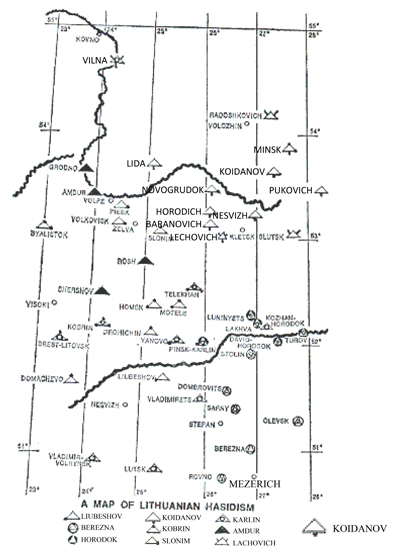
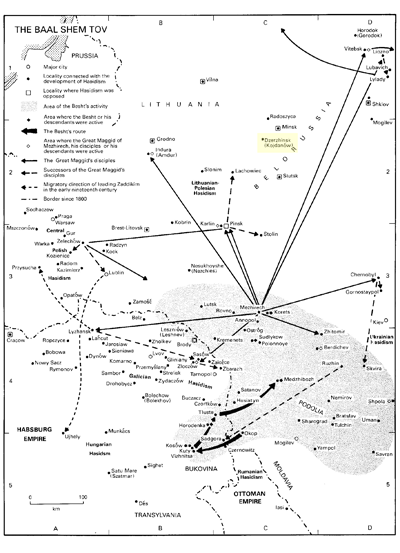
(Click on the map to zoom in.
Click again to zoom in further.) Map of the Spread of Hasidism
(Click on the map to zoom in.
Click again to zoom in further.)
The mostly young men who comprised the Maggid's Chevra Kadisha (Holy Society) were dedicated and gifted, both intellectually and spiritually. Many were Torah and Talmudic scholars who had also become masters of Kabbalah and the techniques associated with ecstatic, meditative prayer. The early disciples who were educated and inspired at the Maggid's Chevra Kadisha in Mezeritch, believed that much of the established rabbinic leadership had, to some extent, become too religiously conservative and apprehensive of spiritual innovation.* Many believed that the rabbinate had become estranged from the needs and religious yearnings of the average Jew. These early Hasidic leaders believed that they were called by Gd and directed by the Besht and the Maggid to heal the subsequent spiritual abyss that had developed between the shtetl Jew and Gd.
*Many scholars characterize this 'rabbinic conservatism' as an understandable response to the false Messiah movements of Shabbatei Tzvi and Jacob Frank.
Included among the Maggid's inner circle of disciples was the future founder of the Karlin branch of Hasidism, Rabbi Aaron ben Jacob, also known as R. Aaron HaGadol (the Great) 1736-72.3 The growth of the Karlin Hasidim would eventually lead to the establishment of the Lechovitch, Stolin, and Koidanov Hasidic dynasties. During the early 1760s, R. Aaron, frequently traveled north from his home in Karlin to preach the Maggid's Hasidic form of Jewish worship throughout the communities of Lithuania. He established Hasidic communities as far north as Minsk and Vilna. The early Lithuanian Hasidim were often referred to by their more traditional Jewish opponents (the Mitnagdim) as "Karliners."4 A central characteristic of Hasidism is the emphasis upon intense, ecstatic prayer alongside of traditional study and scholarship. Another foundational element of Hasidism is the central role played by the Zaddik/Rebbe within the community. R. Aaron, along with many of the early dynastic leaders, was recognized as a wonder worker. These Rebbes were often called upon to intercede with the divine (through prayer) to improve the material lives of their Hasidim. A Hasid would turn to his Rebbe for advice about who to marry and where to live. He would often petition his Rebbe to intercede on his behalf in business, health and fertility. However, it was not miracles and prophecy that bound the Hasid to his Rebbe. It was rather, a deep spiritual and emotional attachment as testified by M. Inveski in his recollections about the Koidanov Hasidim and their Rebbe, Aaron Perlov. As stated below, 'The Rebbe's miracles were not the greatest things for us; it was especially when the miracles did not occur, that we first understand the greatness of the Rebbe.'
The success of these early Hasidic leaders resulted in fierce opposition from traditional Jewish leaders, culminating in the first of several excommunication orders (Herem) initially issued in Vilna in 1772 and supported by Rabbi Elijah of Vilna (The Vilna Gaon, 1720-1797). That same year witnessed the first partition of Poland and the sudden and unexpected death of R. Aaron the Great. He was 36 years old. R. Aaron's teacher, R. Dov Ber of Mezeritch passed away a few months later. With the second partition of Poland in 1793, the shtetl Koidanov became a part of the Russian empire. As a result of all three partitions of Poland, the empress Katherine the Great inherited over a million new Jewish subjects. Katherine died in 1796 and Hasidism's severest opponent, Elijah, the Gaon of Vilna, passed away a year later in 1797.
A disciple of both R. Dov Ber and R. Aaron the Great, Rabbi Shlomo of Karlin (1738-1792) would inherit the mantle of leadership of Karlin Hasidism during the next challenging but fruitful years. R. Shlomo took in and raised Rabbi Aaron the Great's fatherless young son, Asher. R. Shlomo echoed the Hasidic emphasis upon prayer in his belief "that prayer was the utmost of importance and that to teach Jews to pour out their hearts to the Almighty was the greatest miracle."5 R. Shlomo of Karlin led a small but growing cadre of disciples who were able to sustain the young Hasidic movement in the face of a growing opposition. During this period, the Mitnagdim issued a more severe and extensive excommunication order in 1781. R. Shlomo would be shot by a Russian soldier in 1792. He was leading services and was in the midst of davening (praying) when the fatal shot was fired.6 Two of R. Shlomo's prominent disciples were R. Aaron the Great's son, Rabbi Asher and Rabbi Mordechai. R. Asher (1760-1828) became the Rebbe of the Stolin Hasidim and R. Mordechai (1742-1810) established the Lechovitch Hasidic dynasty.*
R. Mordechai of Lechovitch highlighted the importance of self-sacrifice, humility and even self-abnegation during prayer with the goal of achieving devequt (communion/union with Gd). He told a story about "a legendary bird that sang so beautifully, it lost its own soul through the music. That's the type of self-sacrifice that we must have when we pray."7 R. Mordechai also recognized that each succeeding Rebbe possessed different insights and unique talents but that each "tzaddik cannot say any words of the teaching unless he first links his soul to the soul of his dead teacher or to that of his teacher's teacher. Only then is link joined to link and the teachings flow from Moses to Joshua, from Joshua to the elders, and so on to the tzaddik's own teacher, and from his teacher to him."8
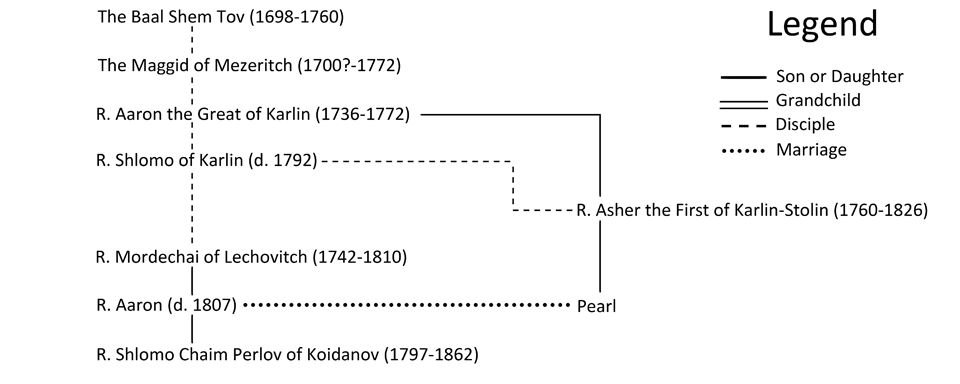
Beside being disciples of R. Shlomo of Karlin, R. Mordechai of Lechovitch and R. Asher of Stolin were colleagues and close friends. R. Mordechai served as the Sandek at the Bris (circumcision) of R. Asher's son.9 The children of these two Hasidic giants would marry. R. Mordechai's son Aaron married Pearl,** the daughter of R. Asher. R. Aaron died while still a young man in 1807 leaving behind his wife Pearl, several daughters and their 10-year-old son, Shlomo Chaim. R. Shlomo Chaim Perlov (1792-1862) would become the founder of the Koidanov Hasidic dynasty.
Pearl and young Shlomo Chaim lived with R. Asher after Aaron's untimely death. R. Shlomo Chaim was married in Stolin in 1810 at the age of 13.*** His paternal grandfather, R. Mordechai of Lechovitch, died on the way to the wedding and is buried in Stolin. The young Shlomo Chaim continued living in the home of his maternal grandfather, R. Asher, after his marriage.10 As of now, we do not know the name of R. Shlomo Chaim's wife.11**** R. Shlomo Chaim would soon become a Rav in Stolin and later Rav in the small town of Turov not far from Stolin.
R. Shlomo Chaim's uncle, R. Noah, succeeded R. Mordechai as the Lechovitch Rebbe. R. Noah of Lechovitch (1774-1832) was married to Rebbetzin Buma (d. 1874). Upon R. Noah's passing, a minority of the Lechovitch Hasidim chose R. Noah's son in-law, R. Mordechai II as their new Rebbe. The overwhelming majority, however, chose R. Shlomo Chaim Perlov as their Rebbe. R. Shlomo Chaim lived in Koidanov during the 1820s and in 1833 he began the process of building a Koidanov Hasidic presence throughout the region.
*R. Mordechai had three sons, Aaron, Noach and Shlomo (the oldest) and at least one daughter whose name we do not know.
**The surname Perlov means "son of Pearl."
***Some sources indicate that Shlomo Chaim lived with his paternal grandfather, R. Mordechai of Lechovitch up until his thirteenth birthday.
**** Sources including Divrei Shalom, by Shalom Perlov and Divrei Aaron by Haussman, indicate that Shlomo Chaim's Rebbetzin was the daughter of R. Dov Moses Zussman.
R. Shlomo Chaim's primary teachers were his grandfathers, R. Asher and R. Mordechai. He also studied with his uncle, R. Noah at his Lechovitch yeshiva. R. Shlomo Chaim's other mentors included: the Mezhibozher Rebbe; the sons of the Zlotzchover Rebbe; the Apter Rebbe; the Chernobiler; the Rizhiner; and the Ovrucher.12 The following story exemplifies the challenges and successes encountered by R. Shlomo Chaim as he worked to establish Hasidic communities outside of Koidanov. "When R. Shlomo Chaim came for the first time to the Lithuanian city of Novogrudok, the mitnagdim threw stones at his carriage, but eventually they became his devoted adherents. R. Shlomo Chaim used to call them his 'precious stones.'"13 Writing in the Radikhov yizkor book, A. Dubinsky depicts the Koidanov Hasidim under R. Shlomo Chaim as a religious movement that “embraced the simpler folk…and aroused in them the desire to study and worship in joy…. Many Chassidim flowed to Rabbi Shlomo-Chaim's sanctuary from all over Lithuania. Even in Vilna, the stronghold of the Mithnagdim, he had faithful followers, who stuck by him with every thread of their hearts and souls.”14
A story by R. Baruch Mordechai relates, "that his father Rabbi Shlomo-Chaim once rebuked him strongly for harboring melancholy feelings. When asked why he particularly argued against this when other shortcomings of his were worse, he answered, 'With regard to other things, you will surely repent, but not for your sorrow, it is very likely that you will never repent for your sorrow.'"15 Another story portrays R. Shlomo Chaim as he confronts an ascetic hermit. "Why do you hate your body? Were you not an ascetic hermit, you would love your body with true love. Therefore go forward, love mankind with a true love, for they are not hermits, withdrawn from the world and they don't abstain from the ways of the world...."16 In another instance a Hasid inquired of R. Shlomo Chaim, "Rabbi, I am old and near the end of my days, will you teach me how to die?" R. Shlomo Chaim answered, "Do you know how to live? Better to learn first how to live, before asking how to die."17 In the Koidanov Siddur, R. Shlomo Chaim admonishes his Hasidim to refrain from idle talk, gossip, levity and slander. His spiritual practices included dressing in white on the Sabbath and setting aside time every day for studying Gemara as well as the Shulkhan Arukh and reading Psalms.18 He loved Hasidic niggunim, and especially enjoyed R. Aaron the Great's liturgical poem, "Lord I Yearn for the Sabbath's Delight (Yah Echsof)."19 R. Shlomo Chaim's humility is evidenced in his last will and testament as he instructs his Hasidim not to speak of him in exuberant or lofty terms. "Do not imagine that I wanted to be a Tzaddik. All I wanted was to be a Jew."20
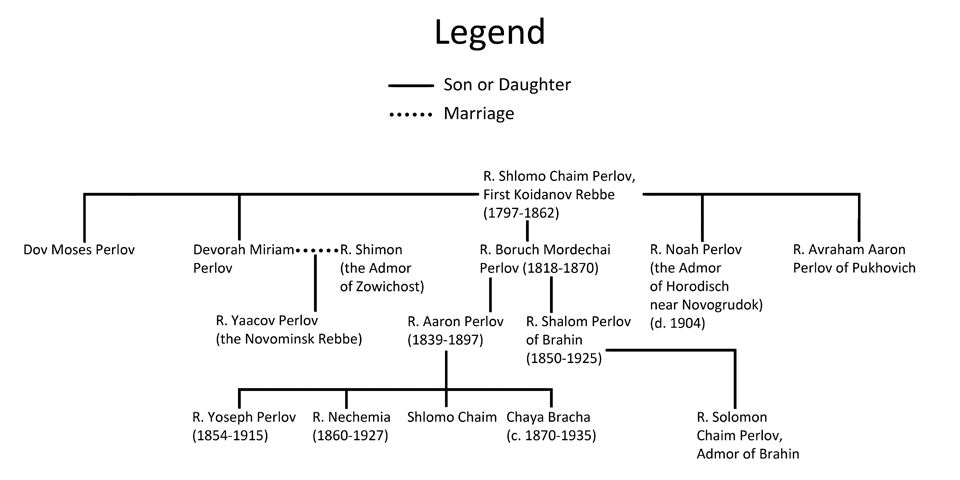
R. Shlomo Chaim, who came to be known as "the old Koidanover," had a son named Dov Moses Perlov who passed away at a young age.21 R. Shlomo Chaim had a daughter named Devorah Miriam who married R. Shimon the Admor of Zowichost in Poland.22 R. Shimon was the son of R. Phineas Katzenellenbogen of Ustilug.23 R. Shimon died at age 43 and his young son Yaacov Perlov was raised in the home of his grandfather, R. Shlomo Chaim. R. Yaacov Perlov established the Novominsk Hasidic tradition and is the grandfather of the acclaimed Rabbi/Professor Abraham Joshua Heschel, who is a great-great grandson of the Koidanover Rebbe, Shlomo Chaim.24
R. Shlomo Chaim's son, R. Noah Perlov (d.1904) became the Admor of Horodisch near Novogrudok. Another son, R. Avraham Aaron became the Rebbe in Pukhovich in the Igumen district. W. Z. Rabinowitcsh notes in his history, Lithuanian Hasidism, that R. Noah and R. Avraham Aaron "enjoyed the good will and support evoked by their family name but had only a limited influence."25 A third son Rabbi Baruch Mordechai (1818-1870) became the second Koidanover Rebbe after R. Shlomo Chaim Perlov died in 1862.26 He married Sarah, the daughter of Shalom of Azad.27 R. Baruch Mordechai is described by his son R. Shalom Perlov as a man "who studied the Torah in poverty and hardship,…became very harsh to his children, paid no attention to what his wife and children said, but gave himself up entirely to the revealed lore and wisdom. He would study patiently, reading every word separately, like a man counting coins and concentrating on it with all his might. And when he prayed, he prayed from his heart, while his hands and whole body trembled for fear of the Lord and of the glory of his majesty…. In those days when the true believers split into various groups, each one of which sought to discredit the others, we heard nothing of this kind from him. He expressed neither contempt nor esteem for any tzaddik."28
All of the Karlin-related Hasidic dynasties collected and sent funds to the Holy Land. R. Baruch Mordechai was selected by his father to raise funds for the Koidanov Kollel in Tiberias. He worked throughout his lifetime to support this cause.29 There is another story in which "a man once came to R. Baruch Mordechai of Koidanov. Signs of intense suffering were etched on the man's face. 'Rebbe,' said the man, 'I have been suffering terribly for a long time. Please give me a bracha (blessing) that I should recover from my illness.' 'I will give you some advice,' responded the Rebbe. 'Be extra careful to avoid Shabbes violations, and try your utmost to honor the Sabbath. Do so and Hashem will grant you a speedy recovery.' The man did as the Rebbe had instructed. Shortly thereafter, the excruciating pain that he had been feeling began to subside. Finally, it went away altogether. 'Do not think that I performed a miracle' the Rebbe later told his students. 'It is a "treatment" that the Torah itself recommends, as the verse states: "Rak shivto yiten v'rapo yerapei." The word "shivto" can also be read "shabato," meaning "his Shabbos." The verse can therefore be read as follows: Let him give his Shabbos, and he will surely be healed.'"30
R. Baruch Mordechai's son, R. Shalom Perlov (1850-1925), began his rabbinic career in the shtetl Lida in 1878. There were two Hasidic communities in Lida, one Lubavitch, the other Koidanov. The Hasidic presence in Lida was still considerably smaller than the traditional/ mitnagdim. The Koidanov Hasidic community was begun and/or nurtured by Reb Benjamin of Lida, "a great Hasid, a miracle performer."31 R. Benjamin was raised by and was a disciple of R. Shlomo Chaim. R. Shalom Perlov arrived in Lida a few years after Reb Benjamin and worked to inspire Hasidic traditions while helping to mend fences with the mitnagdim of Lida. A good example of this cooperation encouraged by R. Shalom is the affirming introduction written by the non-Hasidic, much older and established Rabbi of Lida, Mordechai Meltzer to R. Shalom's book Devrei Shalom. He wrote: “the rabbi who stands before me established his residence in our camp…. He is the famous rabbi, the great light, young in years and full of wisdom, a branch of the great tree of our fathers.” Upon the passing of R. Meltzer, R. Shalom was considered a candidate for the post of chief Rabbi of Lida. The large mitnagdim population eventually chose Rabbi Yitzaak Yaakov Reinas to lead the Lida shtetl.32
R. Shalom left Lida in 1884, and subsequently became a Rabbi in the town of Brezneh in Volin. R. Shalom married Bracha Zipa Manya who was the daughter of Rabbi Joseph of Brezneh. R. Shalom and Bracha's children were Aaron ben Zion, Chaya Rachel, R. Solomon Chaim, Tirtza and Pearl.33 In 1890 R. Shalom became the rabbi in the town of Brahin in the province of Minsk.34 From this point forward, he has been referred to by the title "Reb Shalom of Brahin." In 1895, R. Shalom wrote Ateret Shalom, a commentary on the liturgical poem "Lord I Yearn for the Sabbath's Delight" by R. Aaron the Great of Karlin. In 1912 he wrote and published Meshmeret Shalom and is the author of Devrei Shalom as well.35 R. Shalom's written histories of the Koidanov Hasidic dynasty constitute an invaluable resource. His writings are not as yet translated into English. R. Shalom's son, Rabbi Solomon Chaim Perlov succeeded his father as the Admor of Brahin.36
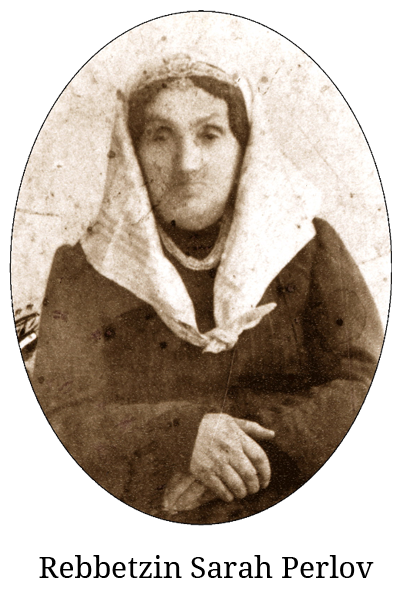

"This witty, warm Reb Areleh was one of the greatest khassidic Rebbes. Koidanov khassidus established a new direction. It is a fine blend of Torah and religious practice. Reb Areleh of Koidanov breathed a new spirit of life into Lithuanian khassidus." M. Inveski37
"The Koidanov khassidim used to say: 'The Rebbe's miracles were not the greatest things for us; it was especially when the miracles did not occur, that we first understand the greatness of the Rebbe.'" M. Ivenski38
Rabbi Aaron Perlov (1839-1897) succeeded his father R. Baruch Mordechai as the Koidanover Rebbe in 1871. The Koidanov Hasidic dynasty experienced exciting growth and increased influence due in large part to the spiritual gifts, as well as the organizational abilities of R. Aaron. R. Aaron headed the Lechovitch shtiebl while his father was still alive. During this period R. Aaron fashioned an appeal directed towards all Koidanov Hasidim to support the Kollel in Tiberias, which had been suffering a series of terrible setbacks, including widespread disease. "People of the Lord, let us be strong and strengthen each other on behalf of the cities of Gd, on behalf of our kinsmen!... Let no one of our followers change his contribution… from every couple one gold piece; let the poor not give less than that, apart from the regular yearly contributions to Eretz Israel…."39 R. Aaron's unrelenting commitment to the Holy Land (like all the Koidanov Rebbes before and after) was foundational to his Hasidic world view. However, his opposition to non-religious Zionism was equally fervent. He was particularly opposed to the Hoverei Zion movement. Hoverei Zion (Lovers of Zion) was begun in the early 1880s partially in response to recent pogroms. It sought to establish agricultural settlements in Palestine. R. Aaron prohibited his Hasidim from supporting this movement, saying that "Whoever gives money to Hoverei Zion, forfeits his reward in the world to come, despite all the charitable deeds that he may have performed and may yet perform throughout his life."40
R. Aaron wrote the introduction to the Koidanov siddur (prayer book) entitled Or ha Yashar (The Direct Light), which was first published in 1877 and is still in use today. The title page of Or ha Yashar contains R. Aaron's "Eight Principles," which when carried out by eight of the body's organs, will lead to perfection. R. Aaron is credited with the publication of Rabbi Moshe Cordovero's Or Neerav, which included an appendix written by R. Aaron entitled Nireh Or, published posthumously in 1899.41 The Koidanov siddur is recognized as an important resource that helped to extend Koidanov Hasidic traditions throughout Lithuania as well as the U.S. and Israel.
More important than R. Aaron's ability to gather and direct resources, was his ability to teach and inspire. He was both a scholar as well as a noted Kabbalist. "The Rebbe was a small, thin man, with eyes that would see right through to the soul. He had a magnetic capacity to hypnotize his khassidim."42 He was a charismatic individual with a special gift, which greatly enhanced his ability to grow the Koidanov Hasidic movement. Hundreds of R. Aaron's followers would trek to Koidanov during major Jewish holidays to see and hear their Rebbe. They traveled by foot, wagon and train. "The train would stop there for only one minute. For Rosh Hashannah a few hundred khassidim would take advantage of this train. From the stop over place to the town was a few viorst (slightly longer than a kilometer), and on a few trips there were many minyanim (quorums of ten men). Some would go on foot. The road to the town would be filled with khassidic songs -- old songs, new songs, songs such as the Koidanov 'Yismekhu be'malkhuskho,' and other songs…. In the center of the Rebbe's court, was the little khassidic synagogue (shtiebl), the Rebbe's shul. Near to that was the residence of the honored Rebbe himself. In the Rebbe's court, the rebbetzin [Sarah, his wife], a heavy-set, attractive, respected woman, would distribute honey cake after the prayers were completed.* Around the residence of the Rebbe lived his married children, three sons and two daughters."43
*'The Unbroken Chain' lists Reb Aaron's wife as Chanah. R. Mordechai Pupko, a descendant of Reb Yoseph, is certain that Reb Aaron's rebbetzin was Sarah Perlov.
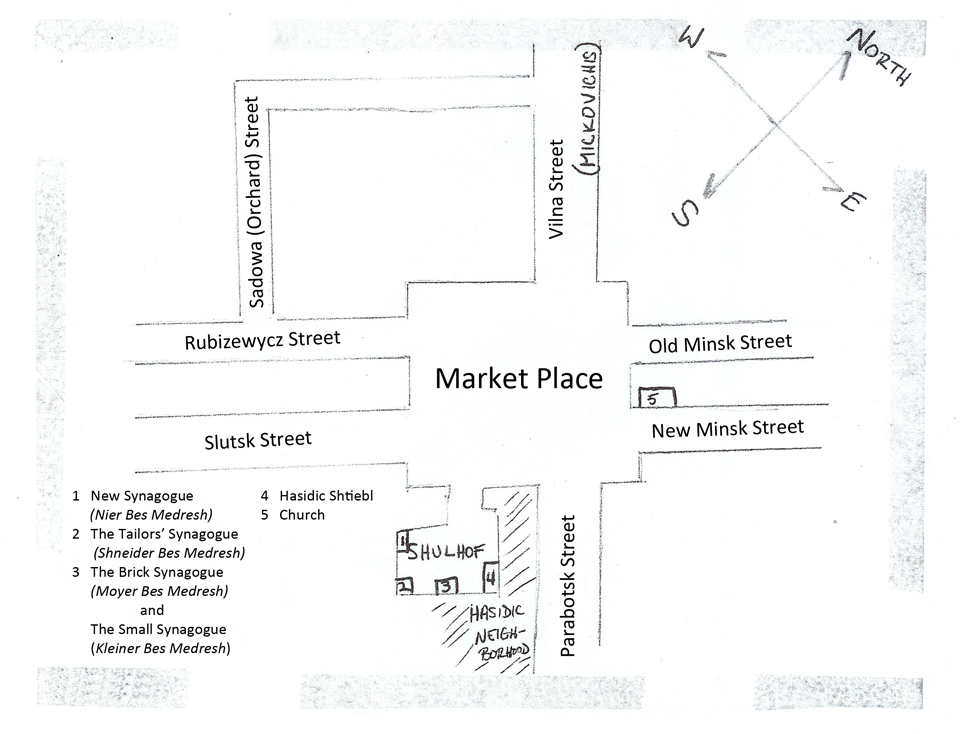
Koidanov Market and Shul Court
Isaac Rivkind also recalls Rosh Hashanah at R. Aaron's Hasidic shtiebl in Koidanov. "On Erev Rosh Hashanah thousands of guests came to our town. The sound of prayer, song and melodies broke through all the houses. On Rosh Hashanah the shtiebl of the Rebbe was packed to the brim with all the people coming to pray, so they would open the windows on the roof and many prayed on the roof. Many people also prayed around the shtiebl surrounding the windows. It was incredibly pleasurable to hear the voice of the Rebbe's prayers. A level of enchantment was on the faces of all that heard the prayers. Until today, I cannot forget the Torah reading of Rabbi Aharla --his pleasant voice and splendor of sanctity that was upon the congregation. The Chassidim prayed with songs and dances without discriminating between the poor person and rich person. Everyone grabbed hold of his neighbor's belt and danced in circles. I was jealous of those people--with their outward spirit reached the level of Bitul ha-Yeish--close to complete spiritual bliss, without worries about business or family issues, towards Gd they focused their eyes and upon the blessing of the Rebbe they relied for their hope, and they had upon whom to rely...."44 In his memoir/letter "From The Recent Past But Ever Far Away," Rivkind recounts that "all the Jews of the town went to Tashlich [at the Natzatza river/stream]. The holiness of the Chassidic procession would cover the town. The Chassidim would escort their Rebbe to Tashlich with songs and dance.45"
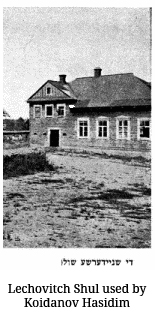 R. Aaron would sometimes travel to Koidanov Hasidic communities outside of Koidanov. Avrom Lev describes his remembrances of the Koidanover Rebbe's visit to Lechovitch in his memoir, "A Walk Through My Devastated Shtetl." "The Koidanover Rebbe used to come to the shtetl once a year--then, vey, vey, what a rumpus was kicked up here, in this corner (of town). The whole Shul Hoyf was thrown into complete turmoil. The Koidanover shul was too confined to accommodate the huge crowds of Jews who gathered to catch either a little word of Torah or a few shraiyim [crumbs from the Rebbe's table] or just to have a part in the holy celebration. I remember how once at such a celebration I almost caught a slap from my father, Dovid-Shloime, a passionate Koidanover chossid, when out of the blue I asked him how a saintly Jew was permitted to countenance such Jews, who would become frenzied, leaping before him with such fervour, and singing and dancing and clapping their hands like crazy people and why did he not shun that kind of 'honour!' 'You Shaygetz!' [ignoramus], he shouted at me very angrily. 'You're deficient!… don't you understand yet that the Rebbe has to live in great style, because the honor done him is not (actually) for him but for the Holy Torah and for the Almighty whose faithful envoy he only is!'"46
R. Aaron would sometimes travel to Koidanov Hasidic communities outside of Koidanov. Avrom Lev describes his remembrances of the Koidanover Rebbe's visit to Lechovitch in his memoir, "A Walk Through My Devastated Shtetl." "The Koidanover Rebbe used to come to the shtetl once a year--then, vey, vey, what a rumpus was kicked up here, in this corner (of town). The whole Shul Hoyf was thrown into complete turmoil. The Koidanover shul was too confined to accommodate the huge crowds of Jews who gathered to catch either a little word of Torah or a few shraiyim [crumbs from the Rebbe's table] or just to have a part in the holy celebration. I remember how once at such a celebration I almost caught a slap from my father, Dovid-Shloime, a passionate Koidanover chossid, when out of the blue I asked him how a saintly Jew was permitted to countenance such Jews, who would become frenzied, leaping before him with such fervour, and singing and dancing and clapping their hands like crazy people and why did he not shun that kind of 'honour!' 'You Shaygetz!' [ignoramus], he shouted at me very angrily. 'You're deficient!… don't you understand yet that the Rebbe has to live in great style, because the honor done him is not (actually) for him but for the Holy Torah and for the Almighty whose faithful envoy he only is!'"46
On a lighter note, R. Aaron was known to have a fine and sharp sense of humor. Once a visiting Rabbi speaking to the Koidanov hasidim was articulating very complicated dialectical arguments. "The khassidim weren't impressed and didn't want to hear this. So, the Rebbe said: 'Let him finish. He doesn't want to transgress on the law of "one is not permitted to hold oneself back" [one must go to the bathroom if one feels the urge].'"47
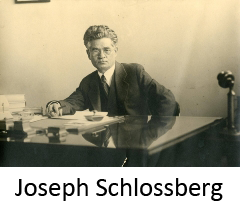 The Amalgamated Clothing Workers union leader, Joseph Schlossberg, who grew up in Koidanov, recalled that under R. Aaron's leadership "the hasidim and the mithnagdim [of Koidanov] were on good neighborly terms, but they did not intermarry…. Many of Koidanov's Hasidim would pray in the 'tailors synagogue'… on weekdays" when they did not have the time to draw out their prayers, as was their custom in their own prayer house.48 Schlossberg relates an incident he witnessed as a young man, in which the town's Hasidim were conducting a public prayer for R. Aaron who was obligated to appear at the district court in Vilna. "What I saw that day made a tremendous impression on me. I had the feeling that here under my very eyes there was a direct link, both visible and invisible, between the Rebbe in the district court in Vilna, the hasidim in Koidanov, and the Holy one Blessed Be He in Heaven. Fascinated, I followed the prayers, which were uttered with ecstatic fervor…. The bottle of brandy, which was there for all the congregation to drink from, added a special liveliness to the atmosphere…. The Rebbe had been acquitted and the hasidim were instructed to sing the song of praise Az Yashir (the song sung over the Egyptians who drowned in the Red Sea). This instruction was carried out with tremendous enthusiasm. The singing of the hasidim could be heard all over Koidanov; and when it ended, the barrel of liquor was found to have been drained dry. The mithnagdim, too, joined in the rejoicing."49
The Amalgamated Clothing Workers union leader, Joseph Schlossberg, who grew up in Koidanov, recalled that under R. Aaron's leadership "the hasidim and the mithnagdim [of Koidanov] were on good neighborly terms, but they did not intermarry…. Many of Koidanov's Hasidim would pray in the 'tailors synagogue'… on weekdays" when they did not have the time to draw out their prayers, as was their custom in their own prayer house.48 Schlossberg relates an incident he witnessed as a young man, in which the town's Hasidim were conducting a public prayer for R. Aaron who was obligated to appear at the district court in Vilna. "What I saw that day made a tremendous impression on me. I had the feeling that here under my very eyes there was a direct link, both visible and invisible, between the Rebbe in the district court in Vilna, the hasidim in Koidanov, and the Holy one Blessed Be He in Heaven. Fascinated, I followed the prayers, which were uttered with ecstatic fervor…. The bottle of brandy, which was there for all the congregation to drink from, added a special liveliness to the atmosphere…. The Rebbe had been acquitted and the hasidim were instructed to sing the song of praise Az Yashir (the song sung over the Egyptians who drowned in the Red Sea). This instruction was carried out with tremendous enthusiasm. The singing of the hasidim could be heard all over Koidanov; and when it ended, the barrel of liquor was found to have been drained dry. The mithnagdim, too, joined in the rejoicing."49
There is a remarkable story, attributed to R. Aaron's brother, R. Shalom Perlov. In this recounting, R. Shalom describes R. Aaron's attempt to exorcise a dybbuk (possessing spirit) from a young woman. This account is a dramatic and graphic portrayal of the special relationship that exists between a Rebbe and his Hasidim. R. Shalom's recollection also displays the authoritative role of the Rebbe within the community. According to W. Z. Rabinowitsch, this testimony is unique to the history of Lithuanian Hasidism.
Not long after my revered father passed on, a girl a Dybbuk had entered was brought before my brother of blessed memory. I can't describe to you what happened at the first meeting since I was not a witness with my own eyes. But I was told that at that time Aaron took my sainted grandfather's walking cane that of my grandfather, the Rabbi of Lechovitch [sic-great-grandfather] and threatened the Dybbuk with it. The Dybbuk screamed and cursed. They brought the maid to him a second time and I was in the room. She stood near the door. Though the door was closed, she continually beat against it for she wanted to flee. All the time she screamed in voices, though my brother of blessed memory spoke to her she would not answer. He commanded the man who had brought her to whisper a certain holy sentence into her ear and immediately she began to reply to his questions. He asked the spirit his name and he replied. More he gave his father's name, that he was twenty when he died and that it was five years since his death. Then my brother asked "Why do you not want to repeat the 'Shema Yisroel' after me," and he said, "Because my father didn't teach it to me." Though I cannot recall further details of the conversation, we did notice how the Dybbuk began to bark and make all sorts of non-speech noises. And, whenever my brother said to him, "Silence!" in a loud voice, he stopped his noises. My brother then commanded them to take her back to her lodgings and to return her tomorrow. In the beginning my brother wanted to just gather a minyan, but then decided to do this in public, so that all those who would see would learn a lesson.
The next day she did not want to come but she was finally brought to his room. He stood near his desk and held one of the books of the holy Ari in which the rule of the exorcism was written. He looked into the book. We did not hear a single word or sound from him. Repeating to her the holy sentence of yesterday again the Dybbuk replied. He further asked, "What did you do before you possessed the maid?" And the Dybbuk said, "I just moved about." And Aaron asked "Why?" And he answered "Because they didn't want to receive me in the other world." So my brother asked, "What was your sin?" And he refused to tell. Then my brother asked, "Will you let go of this girl?" And the Dybbuk countered with a question, "Will they receive me in the other world?" And my brother said, "I cannot answer this unless you tell me what your sin was." And he refused to tell. My brother said, "Since you do not wish to tell what your sin was, we will force you to leave her." And he turned to the gathered folk and asked them to repeat word by word with him. And he said in a loud voice with great emotion, "We are in agreement and in accordance with the Holy One blessed be He and His-presence that you should leave this maid from the little toe between the nail and the flesh and that you hurt no one." And they all repeated this word by word. Before he thus adjured, he promised the possessing soul that prayers would be said for him and the people would study Torah on his behalf. When they finished the adjuration, the girl sat down on the ground and stretched out her leg, and he, my brother of blessed memory, commanded that the door be opened and that no one should stand near the door. And as a sign that she was cured, she was able to repeat the holy verses by herself, something she could not do while she was possessed.50
R. Aaron was subject to personal tragedies. There is a moving account in the Yizkor book that exemplifies R. Aaron's commitment to Jewish mitzvot as he learns of a terrible loss. A Hasid approached the Rebbe's tisch (table at the communal Sabbath meal) to inform R. Aaron that his beloved young son, Shlomo Chaim, had just passed away.* "Nu, Nu, it is Shabbes,"51 replied R. Aaron and he continued to conduct the Sabbath meal. The gathered Hasidim understood that their Rebbe was keeping the commandment that one is not permitted to mourn during the Sabbath. R. Aaron had four children: sons Yoseph, Nechemia, and Shlomo Chaim; and daughter Chaya Bracha. Rabbi Aaron Perlov, the "old Koidanover," passed away on the 26th of Elul, 1897. He was survived by his wife Rebbetzin Sarah Perlov.52
*R. Aaron’s son, Shlomo Chaim was married to Chaya Mussia, the daughter of R. Nachum Dov Ber Schneerson. Shlomo Chaim and Chaya Mussia did not have children.
R. Yoseph Perlov (1854-1915) succeeded his father R. Aaron as Koidanov Rebbe. The religious and social realities encountered by R. Yoseph during the first half of the twentieth century were very different than those faced by the previous Koidanov Rebbes. Both Reb Yoseph and his younger brother, Reb Nechemia, faced radically different adversaries as well as new opportunities. The opposition of the Mitnagdim had long ago ceased to be a significant issue as both the Mitnagdim and the Hasidim realized that they had far more in common than not. These former enemies would soon unite to resist a new and far more determined and resourceful adversary, the Maskilim.
During the early decades of the twentieth century, the shtetl Koidanov was awash with new ideas and ideologies. Up until the twentieth century, only a few learned and wealthy individuals in Koidanov were able to acquire small, private libraries. With recent advances in publishing, the youth of Koidanov were able to establish a small but growing community library.53 The ideas of the German reformers had found a home in Koidanov as well. The German trained teacher Chaim Yehudah Merlish established a school for girls and was the leader of Koidanov's Poale Zion movement. Enlightenment views also flourished in Koidanov due to its proximity to the much larger and more cosmopolitan cities of Minsk and especially Vilna. New world views also arrived by way of letters from Koidanov Jews who had immigrated to America. In addition, religious competition flourished in the shul court as there were now a total of four traditional synagogues alongside of the Hasidic prayer house that competed for the hearts and minds of Koidanov’s Jews.
Regardless, many Hasidim still journeyed to Koidanov to visit R. Yoseph, especially during Shavuot and Hanukkah. R. Yoseph, possibly in response to the challenges presented by the Haskalah (the Jewish Enlightenment), established a yeshiva called Tomchei Tzedek that served approximately 150 students.54 Also, R. Yoseph often traveled north to teach at and oversee the Koidanov shtiebl in Minsk. R. Yoseph, with assistance from his son-in-law, R. Schneerson-Twersky, raised the funds to have a shul built in Jerusalem in 1908. Beyt Yosef still exists and is operated by Chabad. R. Yoseph died while visiting the Koidanov shtiebl in Minsk during Hanukkah of 1915, and is buried in Minsk.55
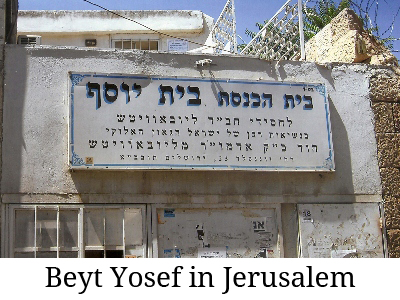

R. Yoseph's first wife was named Shifra (his second cousin) and she was the daughter of R. Noah Perlov of Gorodisce.56 R. Yoseph and Shifra had four children. Zivia Necha, Menucha Naomi, Esther Hadassah and Alter Shlomo Chaim. Zivia Necha married R. Solomon Haim Ortenberg and passed away at a relatively young age. Esther Hadassah married R. Menachem Nachum Rabinowitz (1887-1959). He was the admor of Kantikoziba-Haifa and served as the Rosh Yeshiva of R. Yoseph's Tomchei Tzedek. R. Alter Shlomo Chaim (d. 1916) married Chasel, the daughter of R. Abraham Samuel Pechenik of Brezna. Menucha Naomi married R. Moshe Chaim Yehoshua Schneerson Twersky (see below).57
R. Yoseph's second wife was Chaya Sheindel, who was the daughter of R. Jacob Isaac Rabinowitz. They had five children, Aaron, Chanah, Yaakov Yitzak, Abraham David Mordechai, and Sarah. Aaron died young. Chanah (d. 1979) married R. Samuel Epstein of Vilna. R. Yaakov Yitzak (1903-1919) succeeded R. Yoseph as Rebbe and began to attract Hasidim as a yenuka (child tsadik).58 He was appointed Koidanover Rebbe immediately following his bar mitzvah. R. Yaakov Yitzak passed away during a typhus epidemic three years later at the age of 16.59 R. Abraham David Mordechai married Chaya Yente, the daughter of his half-sister, Menucha Naomi. He received smicha (ordination) from the Chofez Chaim Yeshiva and immigrated to New York City.60 He was encouraged to become a Koidanov Rebbe in the U.S. He preferred not to make his living as a Rabbi and became a businessman in New York. Sarah perished alongside her mother, Chaya Sheindel, during the Shoah.61
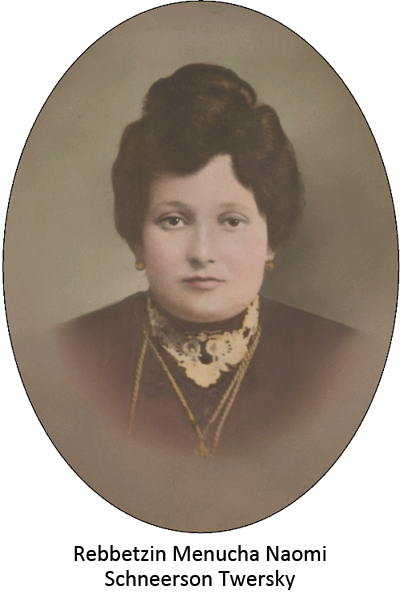
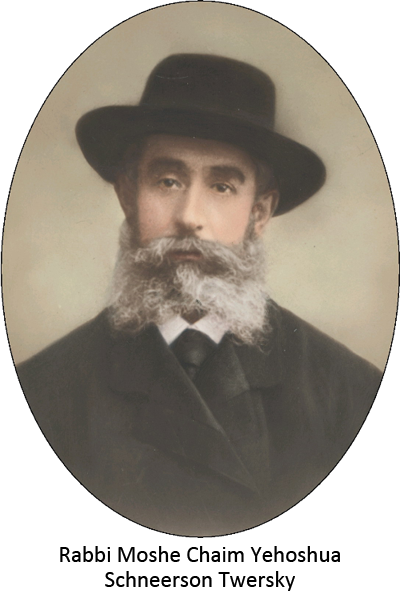
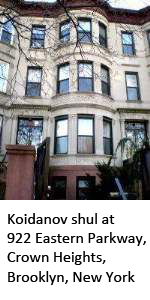 R. Yoseph's daughter Menucha Naomi (12/15/1880-1952) married Rabbi Moshe Chaim Yehoshua Schneerson Twersky (1869-1959) in Koidanov on Sept. 15, 1902. Menucha and her husband immigrated to New York City in 1925.62 Several Koidanov shuls had been established on the lower East side around the turn of the century and a significant contingent of Koidanov Hasidim were on hand to welcome R. Schneerson Twersky. Around 1928, a beautiful limestone building at 922 Eastern Parkway in the Crown Heights section of Brooklyn was purchased. "922" served as both congregational shul and home for R. Schneerson Twersky and his family. Rabbi Mordechai Dov Pupko, (son of Shifra and Chaim Yitzak) and the grandson of R. Schneerson Twersky, describes his grandfather as a Rebbe who exhibited great love and empathy for his fellow Jew regardless of their level of religious observance. "He was extremely tolerant and believed that you should love your brother as you love yourself, no matter what." Rabbi Pupko recalls that his grandfather had a beautiful singing voice. Rabbi Schneerson Twersky lived into his nineties. Rabbi Pupko relates that his grandfather "never cut his peyos…. When he emerged from the mikvah, his peyos reached all the way to his ankles."63
R. Yoseph's daughter Menucha Naomi (12/15/1880-1952) married Rabbi Moshe Chaim Yehoshua Schneerson Twersky (1869-1959) in Koidanov on Sept. 15, 1902. Menucha and her husband immigrated to New York City in 1925.62 Several Koidanov shuls had been established on the lower East side around the turn of the century and a significant contingent of Koidanov Hasidim were on hand to welcome R. Schneerson Twersky. Around 1928, a beautiful limestone building at 922 Eastern Parkway in the Crown Heights section of Brooklyn was purchased. "922" served as both congregational shul and home for R. Schneerson Twersky and his family. Rabbi Mordechai Dov Pupko, (son of Shifra and Chaim Yitzak) and the grandson of R. Schneerson Twersky, describes his grandfather as a Rebbe who exhibited great love and empathy for his fellow Jew regardless of their level of religious observance. "He was extremely tolerant and believed that you should love your brother as you love yourself, no matter what." Rabbi Pupko recalls that his grandfather had a beautiful singing voice. Rabbi Schneerson Twersky lived into his nineties. Rabbi Pupko relates that his grandfather "never cut his peyos…. When he emerged from the mikvah, his peyos reached all the way to his ankles."63
R. Nechemia Perlov (1860-1927) was the younger brother of R. Yoseph and served as the Koidanov Rebbe at Baranovitch (after the passing of R. Yoseph's son Yaakov Yitzak) beginning about 1921. The previous year, Koidanov had suffered a Polish led pogrom. A significant portion of the shtetl had been burned down and Koidanov's Jews were traumatized.64 In addition, WWI and the Soviet Revolution had resulted in accelerated emigration especially by the shtetl youth. These historical events had a devastating impact upon Koidanov's religious, economic and social institutions. Avraham Reisen documented Koidanov's radical decline in his poem, My Return Home in 1928. In contrast, nearby Baranovitch was at the crossroads of the Lvov/Vilna and the Moscow/Warsaw railroad lines and had a growing population of 11,000 citizens (1920), the majority of whom were Jewish.65 Baranovitch presented a logical alternative to remaining in a diminished Koidanov.
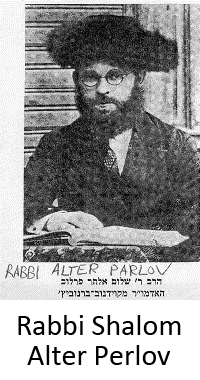 R. Nechemia married Rivka Henia, the daughter of Naftali Tzvi Rubin, the Rebbe of Radichev. R. Nechemia and Rivka Henia had two sons, R. Shalom Alter Perlov (1904-1943) and R. Naftali Perlov as well as a daughter, Rebbetzin Chana Sarah Glickman.66 R. Naftali Perlov married Henia (Rokeach)67. R. Shalom Alter, the youngest son of R. Nechemia, studied at the yeshiva Ohel Torah under Rabbi Elchanan Bunim Wasserman in Baranovitch. R. Shalom Alter succeeded his father as the Koidanov Rebbe at Baranovitch in 1927. Soon afterward he married Pearl, the daughter of R. Yerahmiel Tzvi Rabinowicz of Siedlice in 192868. Rebbetzin Pearl was celebrated for establishing the women's Bet HaMidrash in Vilna during WWII. The women met at 9 Bet Haholin Street where they studied Torah, Rashi and Pirket Avot. Occasionally the Rebbetzin invited male lecturers to address the women's study group. Rebbetzin Pearl died of typhus in the Danzig concentration camp. R. Shalom Alter was murdered by the Nazis and their Lithuanian collaborators at the Ponary Forest outside of Vilna. R. Shalom Alter and Pearl had no children.69
R. Nechemia married Rivka Henia, the daughter of Naftali Tzvi Rubin, the Rebbe of Radichev. R. Nechemia and Rivka Henia had two sons, R. Shalom Alter Perlov (1904-1943) and R. Naftali Perlov as well as a daughter, Rebbetzin Chana Sarah Glickman.66 R. Naftali Perlov married Henia (Rokeach)67. R. Shalom Alter, the youngest son of R. Nechemia, studied at the yeshiva Ohel Torah under Rabbi Elchanan Bunim Wasserman in Baranovitch. R. Shalom Alter succeeded his father as the Koidanov Rebbe at Baranovitch in 1927. Soon afterward he married Pearl, the daughter of R. Yerahmiel Tzvi Rabinowicz of Siedlice in 192868. Rebbetzin Pearl was celebrated for establishing the women's Bet HaMidrash in Vilna during WWII. The women met at 9 Bet Haholin Street where they studied Torah, Rashi and Pirket Avot. Occasionally the Rebbetzin invited male lecturers to address the women's study group. Rebbetzin Pearl died of typhus in the Danzig concentration camp. R. Shalom Alter was murdered by the Nazis and their Lithuanian collaborators at the Ponary Forest outside of Vilna. R. Shalom Alter and Pearl had no children.69
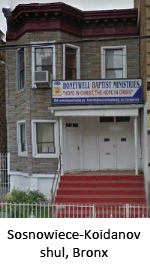 R. Nechemia's daughter, Chana Sarah (1903-1982) married Rabbi Naftoli Glickman (b.1904) from Sosnowiece (R. Naftoli was the son of Yitzak Glickman, the Sosnowiece Rebbe). R. Glickman and Chana Sarah had a son, R. Nechemia Isaac Glickman (b.1935).70 They were committed religious Zionists who were involved in the Mizrachi movement. During the late 1930s, the Soviet government exiled the entire family to Siberia. The family was finally able to immigrate to the United States in 1947. Shortly after arriving in New York City, R. Naftoli Glickman purchased a two-story building at 2024 Honeywell Ave. in the Bronx and established a Sosnowiece-Koidanov shul. The family lived on the second floor, above the shul. Their son, R. Nechemia Isaac Glickman, a grandson of the Koidanov Rebbe Nechemia of Baranovich, became a prominent engineer as well as a Rabbi. He received smicha (ordination) from the yeshiva Mesivta Tiferes Yerushalayim and recalls with affection his teacher, the renowned Rabbi Moshe Feinstein. R. Nechemia Isaac Glickman married Leah, the great-granddaughter of Reb Yoseph by way of her mother Sarah, the daughter of Esther Hadassah Rabinowitz (Perlov). R. Nechemia and Leah Glickman and their family made aliyah in 1972 and continue the Koidanov Hasidic tradition in Haifa and Tel Aviv.71
R. Nechemia's daughter, Chana Sarah (1903-1982) married Rabbi Naftoli Glickman (b.1904) from Sosnowiece (R. Naftoli was the son of Yitzak Glickman, the Sosnowiece Rebbe). R. Glickman and Chana Sarah had a son, R. Nechemia Isaac Glickman (b.1935).70 They were committed religious Zionists who were involved in the Mizrachi movement. During the late 1930s, the Soviet government exiled the entire family to Siberia. The family was finally able to immigrate to the United States in 1947. Shortly after arriving in New York City, R. Naftoli Glickman purchased a two-story building at 2024 Honeywell Ave. in the Bronx and established a Sosnowiece-Koidanov shul. The family lived on the second floor, above the shul. Their son, R. Nechemia Isaac Glickman, a grandson of the Koidanov Rebbe Nechemia of Baranovich, became a prominent engineer as well as a Rabbi. He received smicha (ordination) from the yeshiva Mesivta Tiferes Yerushalayim and recalls with affection his teacher, the renowned Rabbi Moshe Feinstein. R. Nechemia Isaac Glickman married Leah, the great-granddaughter of Reb Yoseph by way of her mother Sarah, the daughter of Esther Hadassah Rabinowitz (Perlov). R. Nechemia and Leah Glickman and their family made aliyah in 1972 and continue the Koidanov Hasidic tradition in Haifa and Tel Aviv.71
Chaya Bracha Perlov (c. 1870-1935) was the youngest child of R. Aaron. She was significantly younger than her siblings, Yoseph, Nechemia and Shlomo Chaim. Rebbetzin Chaya Bracha is described by her grandson, R. Berish Schapiro, the Naroler Rebbe,* as a brilliant woman who spoke Russian, Hebrew and Yiddish fluently. R. Schapiro recalls that both men and women came to Chaya Bracha with questions and to learn.72 She married Rabbi Meshulam Zalman Yosef Zilberfarb from Toporov, Ukraine (1870-1940). Their wedding in Koidanov was described by Isaac Rivkind in his memoir of growing up in Koidanov.
*The present Naroler Rebbe, Rabbi Dov Berish Shapiro is the son of the late Naroler Rebbe, Rabbi Chaim Myer Yechiel Shapiro. R. Dov Berish is the grandson of Rabbi Meshulam Zalman Yosef Zilberfarb and Rebbetzin Chaya Bracha (Perlov).
"There was a festive atmosphere throughout the whole town. It wasn't only the Jews, but non-Jews alike felt part of the happiness. Even the Catholics sent transportation for the guests and horses for the 'Cossacks.' They weren't really Cossacks, but Hasidim serving as an honor guard and dressed like Cossacks. Motel and Gudi were in charge of this process. The procession of riders went out to greet the groom and his parents at the train station. When they arrived at the town the joy was intense. The 'Cossacks' rode ahead and they were followed by a troupe of musicians. All the fanfare of the parents and many guests followed them. The huge celebration passed through the center of the market several times."73
Chaya Bracha's husband, R. Zilberfarb was a devoted disciple of her father, the Koidanov Rebbe Aaron. Dubinsky explains that "the services and ways of the Lithuanian Chassidim of Koydanov were very different from the Chernobyl-Galician atmosphere in which Rabbi Meshulam-Zalman-Yosef was brought up. But the differences were merely external. Actually, Reb Meshulam-Zalman-Yosef Zilberfarb blended in his character the different approaches, into a glorious peak of pure Chassidic perfection, with magnificent harmony. For he was a wonderful man and wonderful were his traits and ways." R. Zilberfarb was killed during the Shoah along with many family members.74
The Shoah devastated much of the Koidanov Hasidim who remained in Europe, but there were surviving Koidanov Hasidic shuls in the United States. These included Beth Aaron in Brooklyn led by R. Schneerson Twersky and the Sosnowiece-Koidanov shul that was established in the Bronx in 1947 by R. Naftoli Glickman. Several Koidanov Hasidic shuls were established and/or reorganized on the lower East side around the turn of the twentieth century. These included Chevra Beth Aaron Ansche Koydenoff (1893) and Chevra Bnei Mordechai Beit Aaron Chasidem De'Koidenow (1903). Beth Aaron Chassidim d' Koidanov was organized in 1907 at 141 Madison Street and soon afterwards at 148 Madison Street. It had 45 members, provided opportunities for services, study, cemetery access and a free loan society. The president of the congregation was Solomon Katcherdinsky and the secretary was H. Edelman.75 Records indicate that the congregation lasted until 1930. That same year, the Hasidim from Kobrin joined with Koidanov Hasidim to form Congregation Chasidim D'Koidinof Ve'Chasidim D'Kobrin.76
In 1948, the surviving Koidanov Hasidim in Israel asked R. Chanoch Heinech Dov Zilberfarb (1890-1978), who was born in Koidanov and was a surviving son of R. Mehulam Zalman Yosef Zilberfarb and Chaya Bracha, to become their Rebbe. R. Chanoch Heinech was married to Rebbetzin Eidel Dina and was the Rebbe in Botoshon, Romania. He agreed to become the Rebbe for the Koidanover Hasadim in Israel. 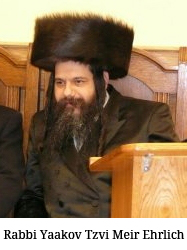 He created a Koidanover Beit Midrash and led his Hasidim in Tel Aviv. R. Chanoch passed away in 1978 and was succeeded by his son R. Aaron Zilberfarb, who passed away in 1994, leaving no heirs. R. Aaron's sister Tzipora married R. Yechiel Micheal Ehrlich. Their son, Rabbi Yaakov Tzvi Meir Ehrlich succeeded his uncle R. Aaron.77 Rebbe Ehrlich has successfully built and led a growing congregation of Koidanov Hasidim in Bnai Brak and Tel Aviv. R. Ehrlich established a successful Kiruv (outreach) center running out of the Koidanov Beit Midrash in Tel Aviv's Dizengoff Square and has also created a Yeshiva Ketanah, while continuing to grow the main Beit Midrash in Bnai Brak. R. Ehrlich is assisted by a devoted cadre of Hasidim, including Rabbi Shlomo Slatkin, who operates the American Friends of Koidanov website. R. Slatkin is a frequent contributor to the "A Simple Jew" blog where he extolls the Koidanov Hasidic world view. R. Slatkin also coordinates fundraising, R. Ehrlich's visits to the U.S., and distributes R. Ehrlich's midrashim by way of email.
He created a Koidanover Beit Midrash and led his Hasidim in Tel Aviv. R. Chanoch passed away in 1978 and was succeeded by his son R. Aaron Zilberfarb, who passed away in 1994, leaving no heirs. R. Aaron's sister Tzipora married R. Yechiel Micheal Ehrlich. Their son, Rabbi Yaakov Tzvi Meir Ehrlich succeeded his uncle R. Aaron.77 Rebbe Ehrlich has successfully built and led a growing congregation of Koidanov Hasidim in Bnai Brak and Tel Aviv. R. Ehrlich established a successful Kiruv (outreach) center running out of the Koidanov Beit Midrash in Tel Aviv's Dizengoff Square and has also created a Yeshiva Ketanah, while continuing to grow the main Beit Midrash in Bnai Brak. R. Ehrlich is assisted by a devoted cadre of Hasidim, including Rabbi Shlomo Slatkin, who operates the American Friends of Koidanov website. R. Slatkin is a frequent contributor to the "A Simple Jew" blog where he extolls the Koidanov Hasidic world view. R. Slatkin also coordinates fundraising, R. Ehrlich's visits to the U.S., and distributes R. Ehrlich's midrashim by way of email.
Koidanov's Hasidic written traditions are disseminated through R. Ehrlich's publishing division, which has published a contemporary edition of the Koidanov siddur. In addition, they publish and distribute the writings of the earlier Koidanov Rebbes, including Meshmeret Shalom by R. Shalom Perlov. Virtually all of Reb Ehrlich's Koidanov Hasidim in Israel today are new to the movement and are not descended from the earlier Koidanov families, many of whom were victims of the Shoah.78
Over the course of almost two centuries, the Koidanov Hasidic dynasty has encountered an impressive measure of historical challenges. Despite these obstacles, the movement was able to establish communities of committed adherents in shtetls and cities throughout Lithuania, in the Ukraine, in the U.S. and in Israel. From its beginnings in 1833 to the present, there were probably no more than several thousand Koidanov Hasidim during any one period. However, the impact of the Koidanov tradition should not be regarded simply in terms of numbers. The significance of the Koidanov Hasidic tradition lies in its ability to transform Jewish lives. From its inception through the present time, the Koidanov Hasid has found meaning, joy and solace through ecstatic prayer, mitzvot, study, dance and song. During the nineteenth and twentieth centuries, the Koidanov Rebbes established a written, living tradition that continues to be both powerful and applicable for contemporary Jews. Today, the Koidanov Hasidic dynasty, though small in number, survives, prospers and remains an authoritative, accessible pathway for Jews who yearn for spiritual growth and religious fulfillment.
Endnotes
1 http://archive.org/stream/CantorsAssemblyConventionProceedings_617/2009_djvu.txt Cantor's Assembly Convention Proceedings, Fall 2009, Volume 34. By Chaim Grade. "Hasidim and Mitnagdim in Vilna Between the Wars," page 198
2 http://www.jewishvirtuallibrary.org/jsource/biography/baal.html
3 http://www.jewishencyclopedia.com/articles/50-aaron-ben-jacob-of-karlin
4 W. Z. Rabinowitsch, Lithuanian Hasidism. London: The Garden City Press Ltd, 1970, page 15
5 Encyclopedia of Hasidism by Rabinowicz, Tzvi M. page 456
6 Encyclopedia of Hasidism by Rabinowicz, Tzvi M. page 456
7 Koidanov; Memorial Volume of the Martyrs of Koidanov. "The Koydanover Rabbi, Reb Ahrele." M. Ivensky, page 58
8 "Teachings of the Rabbis of Lyakhovichi," by Deborah G. Glassman. http://kehilalinks.jewishgen.org/lyakhovichi/teachings.htm
9 W. Z. Rabinowitsch, Lithuanian Hasidism, page 154-5
10 W. Z. Rabinowitsch, Lithuanian Hasidism, page 162
11 Email from Rabbi Shlomo Slatkin, December 2013 and Neil Rosenstein, The Unbroken Chain, volume II. Page 881
12 http://kehilalinks.jewishgen.org/lyakhovichi/rabbonim.htm "Rabbonim, Rebbes, and Crown Rabbis of Lyakhovichi," by Deborah G. Glassman. Shlomo Hayim biography
13 W. Z Rabinowitsch, Lithuanian Hasidism. page 196, footnote #33. Originally from Devrei Shalom by Shalom Perlov, page 15
14 Memorial book of Radikhov. "Toporov," page 411
15 Memorial book of Radikhov. "Toporov," page 411
16 Memorial book of Radikhov. "Toporov," page 413
17 Memorial book of Radikhov. "Toporov," page 413
18 Koidanov Siddur, Or ha Yashar
19 W. Z Rabinowitsch, Lithuanian Hasidism. page 162
20 Tzvi M. Rabinowiz, The Encyclopedia of Hasidism. page 367
21 Neil Rosenstein, The Unbroken Chain, volume II. page 881
22 Email from Moshe Shurin, 11/22/13
23 Neil Rosenstein, The Unbroken Chain, volume II. page 884
24 Edward K. Kaplan, Samuel H. Dresner, Abraham Joshua Heschel: Prophetic Witness. page 10
25 W. Z. Rabinowitsch, Lithuanian Hasidism. page 164
26 W. Z. Rabinowitsch, Lithuanian Hasidism. page 164
27 Encyclopedia of Hasidism by Tzvi M. Rabinowicz. page 363 and http://www.geni.com/people/Rabbi-Baruch-Mordechai-Perlow/6000000006712243434?through=6000000006989021926
28 W. Z. Rabinowitsch, Lithuanian Hasidism. page 163
29 W. Z. Rabinowitsch, Lithuanian Hasidism. page 163
30 Rabbi Yisrael Bronstein. http://shiratdevorah.blogspot.com/2011/01/complete-recovery.html
31 Lida Yizkor book. Chapter "Center of Learning" pages 89-93
32 Lida Yizkor book. page 89-93
33 Neil Rosenstein, The Unbroken Chain, volume. II. page 883
34 Lida Yizkor book. page 98
35 Encyclopedia of Hasidism by Rabinowicz, Tvi M. page 366
36 Neil Rosenstein, The Unbroken Chain, volume. II. page 883
37 Volume of the Martyrs of Koidanov. "The Koydanover Rabbi, Reb Ahrele," by M. Ivensky, page 63
38 Volume of the Martyrs of Koidanov. "The Koydanover Rabbi, Reb Ahrele." by M. Ivensky, page 58
39 W. Z. Rabinowitsch, Lithuanian Hasidism. page 164
40 Zionism and Religion edited by S. Almog, Jehuda Reinharz and Anita Shapira, page 33
41 W. Z. Rabinowitsch, Lithuanian Hasidism. page 164-5
42 Volume of the Martyrs of Koidanov. "The Koydanover Rabbi, Reb Ahrele." M. Ivensky. page 61
43 Volume of the Martyrs of Koidanov. "The Koydanover Rabbi, Reb Ahrele." M. Ivensky. pages 55-6
44 "From the Recent Past, But Ever Far Away," by Isaac Rivkind, unpublished memoir, page 12
45 "From the Recent Past, But Ever Far Away," by Isaac Rivkind, unpublished memoir, page 4
46 "A Walk Through My Devastated Shtetl," by Avrom Lev. Part IV, 1951. Reprinted in "Rabbonim, Rebbes, and Crown Rabbis of Lyakhovichi," by Deborah G. Glassman/reprinted from the Lechowitz Yizkor book, page 293
47 Volume of the Martyrs of Koidanov. "The Koydanover Rabbi, Reb Ahrele." M. Ivensky. page 62
48 W. Z. Rabinowitsch, Lithuanian Hasidism. page 165. Quoted from an article by Joseph Schlossberg entitled "Hasidism un Mitnagdim Amol in Mein Shtetl," in the Yiddish paper Tog-Morgen, dated 4/12/1957
49 W. Z. Rabinowitsch, Lithuanian Hasidism. page 166. Quoted from an article by Joseph Schlossberg entitled "Hasidism un Mistagdim Amol in Mein Shtetl," in the Yiddish paper Tog-Morgen, dated 4/12/1957
50 http://kehilalinks.jewishgen.org/lyakhovichi/teachings.htm Under the heading "Aaron Perloff." The original recollection was appended to the last will and testament of R. Shalom Perlov of Brahin (Lithuanian Hasidism, page 167)
51 Volume of the Martyrs of Koidanov. "The Koydanover Rabbi, Reb Ahrele." M. Ivensky. page 60
52 Telephone interview with Rabbi Mordechai Dov Pupko, a great grandson of Reb Yoseph. 10/17/13
53 Volume of the Martyrs of Koidanov. "Remembrances and Other Thoughts." B. Grossman. Page 27
54 W. Z. Rabinowitsch, Lithuanian Hasidism. page 168
55 Minsk Yizkor book, volume 1, "Religious Jewry, Its Institutions and Persons," by Ben-Zion Gershoni. page 90 and telephone interview with Rabbi M. Pupko, 10/17/13
56 Rosenstein, Neil. The Unbroken Chain, volume II. Page 882
57 Rosenstein, Neil. The Unbroken Chain, volume II. Page 882
58 Interview with Rabbi Mordechai Dov Pupko at his home/shul in Brooklyn, February, 2012 and a reference from The Unbroken Chain. Page 882
59 Email from Rabbi Shlomo Slatkin concerning the Koidanov Rebbes
60 Rosenstein, Neil. The Unbroken Chain, volume II. Page 882-3
61 Telephone interview with Moshe Shurin, March 3, 2014
62 Petition for Naturalization, filed by Moses Schneerson Twersky, May 1, 1928
63 Interview with Rabbi Modechai Dov Pupko, Brooklyn, February 2012
64 Volume of the Martyrs of Koidanov. Koidanov in 1920(Memories) by Eyda Aynbinder-Liberman, page 186
65 Baranovichi, Wikipedia: http://en.wikipedia.org/wiki/Baranovichi
66 http://www.geni.com/people/Rabbi-Nechemya-Perlow-Koidanover-Rebbe-of-Baranovitsh/6000000006414585005?through=6000000006712167499
67 Geni.com http://www.geni.com/people/Rabbi-Naftoli-Perlov/6000000006712152949
68 Encyclopedia of Hasidism by Rabinowicz,Tzvi M. page 366
69 Encyclopedia of Hasidism by Rabinowicz Tzvi M. page 365
70 Passenger Manifest from the SS Marin Falcon, 1947. Ancestry.com
71 Telephone interview with Nechemia and Leah Glickman. 6/3/12
72 Telephone interview with R. Berish Schapiro, the Naroler Rebbe. September 2012
73 "From the Recent Past, But Ever Far Away," by Isaac Rivkind, unpublished memoir, page 9
74 Radikhov Yizkor book, "Toporov" chapter, pages 411-16
75 The Jewish Communal Register of New York City, 1917-1918
76 Landsmanshaftan and other town and country related organizations incorporated in New York County 1848-1920 in the AJHS collection of New York County incorporations
77 Email from R. Shlomo Slatkin describing the history of the Koidanov Rebbes
78 Volume of the Martyrs of Koidanov. "The Koydanover Relief," by Noakh Rozevitzky. page 11 and telephone conversation with Rabbi Shlomo Slatkin
References
Books
Or ha-Yashar (The Koidanov Siddur/Prayer Book)
Rabinowicz, Tzvi M. The Encyclopedia of Hasidism
Rabinowicz, Tzvi M. Hasidism in Israel
Rabinowitsch, Dr. Wolf Zeev. Lithuanian Hasidism
Jewish Encyclopedia, 1906
Edward K. Kaplan, Samuel H. Dresner, Abraham Joshua Heschel: Prophetic Witness
S. Almog, Jehuda Reinharz and Anita Shapira. Zionism and Religion
Heller, Deborah. The Goose Girl, the Rabbi, and the New York Teachers: A Family Memoir
Rosenstein, Neil. The Unbroken Chain
Unpublished Manuscripts
"From The Recent Past But Ever Far Away, a memoir of growing up in Koidanov," by Yitzak Rivkind 15 pages
"Koidanov," an unpublished undergraduate paper by Bruce Gribetz. 1976
Yizkor Books
Koidanov
Lida
Lechowitz
Minsk
Radikhov
Online Resources
www.jewishvirtuallibrary.org http://www.geni.com/people/Shlomo-Chaim/6000000016616022864?through=6000000006712243434
Lyakhovichi Kehillah website: "Rabbonim, Rebbes, and Crown Rabbis, of Lyakhovichi,"
http://kehilalinks.jewishgen.org/lyakhovichi/lyakhovichi.html
Lechovitch Yizkor book. http://www.jewishgen.org/yizkor/lyakhovichi/Lyakhovichi.html#TOC2
Jewish Population for Towns in Minsk Guberniya
http://www.jewishgen.org/belarus/Vitaly/Town.html
Geni.com
http://www.geni.com/people/Reb-Aharon-PERLOF-of-Koydanov/6000000006712243428?through=6000000006712243422
Shirat Devorah
http://shiratdevorah.blogspot.com/2011/01/complete-recovery.html
YIVO
http://www.yivoencyclopedia.org/article.aspx/Koidanov_Hasidic_Dynasty
Wikipedia, "Narol Hasidic Dynasty"
http://en.wikipedia.org/wiki/Narol_(Hasidic_dynasty)
Jewishgen.com, Belarus SIG
http://www.jewishgen.org/belarus/shtetls/shtetl_detail.php?filename=skoidanovmm
Kevarim.com, R. Schneerson-Twersky
http://kevarim.com/rebbe-chaim-moshe-yehoshua-schneerson-twersky/
"A Simple Jew"
http://asimplejew.blogspot.com/search?q=Rabbi+Shlomo+Slatkin
Map, Hasidism
http://cw.routledge.com/textbooks/0415236614/resources/maps/map49.jpg
The Jewish Communal Register of New York City, 1917-1918 ...
http://books.google.com/books?id=oBpOAAAAMAAJ&pg=PA166&lpg=PA166&dq=Beth+Aaron+Anshei&source=bl&ots=pKoS1oimiQ&sig=gRAQqhc5BSeIfr4a3VV-
WPA Yiddish Writer's Group Study (1938)
http://www.jgsnydb.org/landsmanshaft/wpa2.htm
Online Documents
Petition For Citizenship, Moses Schneerson-Twersky
http://www.yivoencyclopedia.org/article.aspx/Koidanov_Hasidic_Dynasty
Petition For Naturalization, Nechemia Isaac Glickman
http://interactive.ancestry.com/7733/imusany1824_2176-00214/2626007?backurl=http%3a%2f%2fsearch.ancestry.com%2fcgi-
New York Passenger Lists, Ancestry.com, Chana Glickman, 1947
http://interactive.ancestry.com/7488/NYT715_7450-0100/3022676788?backurl=http%3a%2f%2fsearch.ancestry.com%2fcgi-
Petition For Naturalization, Ancestry.com, Chana Glickman
http://interactive.ancestry.com/7733/imusany1824_2193-00129/2630611?backurl=http%3a%2f%2fsearch.ancestry.com%2fcgi-
The Jewish Communal Register of New York City, 1917-1918 ...
http://books.google.com/books?id=oBpOAAAAMAAJ&pg=PA166&lpg=PA166&dq=Beth+Aaron+Anshei&source=bl&ots=pKoS1oimiQ&sig=gRAQqhc5BSeIfr4a3VV-OdA8Nqc&hl=en&
Landsmanshaftan and other town and country related organizations incorporated in NY County 1848-1920. AJHS collection of NY County incorporations.
http://www.jgsnydb.org/landsmanshaft/ajhs.htm
"A Walk Through My Devastated Shtebl (part IV)," by Avrom Lev.
http://kehilalinks.jewishgen.org/lyakhovichi/townhistory-Lev4.htm
Interviews
Telephone interview with Nechemia and Leah Glickman, May 26, 2012
Telephone interview with Sheindy and Moshe Perlow, May 2012
Interview with Zalman Alpert, Chief Librarian at Yeshiva University, May 2012
Telephone Interview with Rabbi Berish Schapiro, 2012
Telephone Interview with Rabbi Yaakov Tzvi Meir Ehrlich, spring of 2013
Telephone Interviews and many emails with Rabbi Shlomo Slatkin beginning in Feb. 2012. R. Slatkin is an invaluable resource for learning about the Koidanov Hasidic dynasty. He runs the American Friends of Koidanov website and is devoted to R. Ehrlich and their mission to sustain and grow the Koidanov Hasidic tradition. He always found the time to help me in my research.
Interview with Rabbi Mordechai Dov Pupko at his Brooklyn home/shul, Spring 2012. Many emails and phone interviews have followed. Rabbi Pupko is a descendant of Reb Yoseph and has always been very kind, generously devoting time, information and photos. He keeps the Koidanov Hasidic tradition and history alive in his Brooklyn shul, Damesek Eliezer Beth Torah.
|
Compiled by Jeff Ferber This site is part of JewishGen’s KehilaLinks (formerly ShtetLinks) project. This site is hosted at no cost to the public by JewishGen, Inc., a non-profit corporation. If you feel there is a benefit to you in accessing this site, your JewishGen-erosity is appreciated. |
Last updated on August 13, 2016 |
|
|


